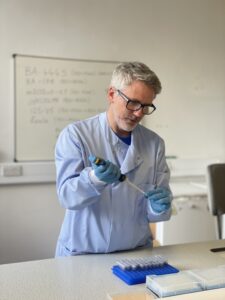Offshore wind energy production is an important component of the Irish renewable energy sector. However, through turbine impacts and barotrauma, studies worldwide have demonstrated that windfarms can cause high instances of bat mortality, particularly for migratory species. Despite this, there remains a paucity of information not just on the potential impacts of offshore windfarm development on Irish bats, but the extent to which bats migrate over open marine waters to and from Ireland in the first place. Focusing on two native Irish species that are migratory elsewhere within their natural range, the Nathusius’ pipistrelle and Leisler’s bat, we aim to identify migratory patterns in Irish populations, which could expose these species to the impacts of offshore wind turbine developments.
Using tissue and fur samples from bats in Ireland, Britain and continental Europe, we aim to compare two unique methods to infer if migration/movement is occurring between these regions. For the first method, we will screen thousands of single nucleotide polymorphisms (SNPs) in individual bats to determine the extent of gene flow/migration between sampled populations. Secondly, fur keratin samples will be subjected to stable isotope analysis for five stable isotopes (hydrogen, oxygen, nitrogen, carbon and sulphur) for a comparison of the isoscape origins of bats between regions. The application of these complementary methods will allow us to determine the extent of migration in these Irish bat species, and will ultimately form the basis of any subsequent mitigation measures which may be needed to avoid impacts of offshore wind energy infrastructure.


